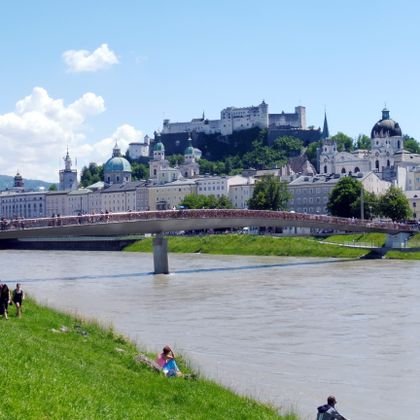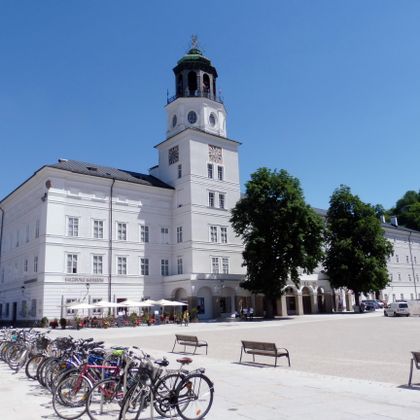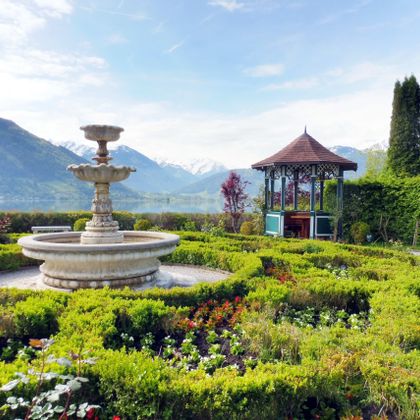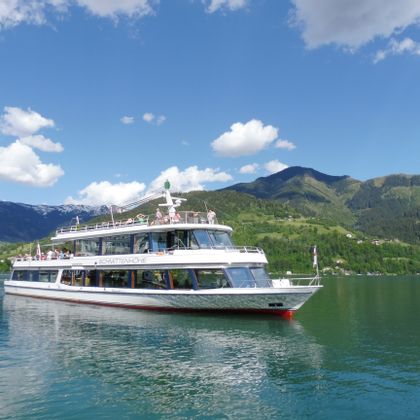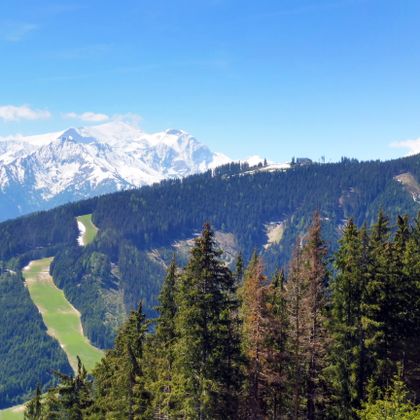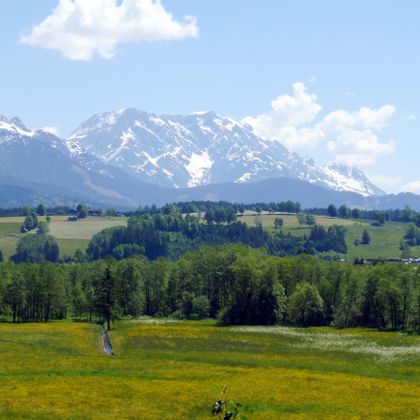Tour
Individual arrival in the festival, Mozart and cultural city of Salzburg. Winding alleys and squares invite you to take a stroll around. Charming, cozy cafes offer Austrian coffee specialties. You breathe in culture and history with every step. You can stroll through Getreidegasse, discover Mozart's birthplace or take the opportunity to go shopping. Outside the festival season, too, you can expect a diverse and sophisticated range of concerts, theater performances and exhibitions.
Your bike journey begins in Salzburg, where the Mozartkugel rolls. You roll slowly through the shady Salzach floodplains to Hallein, a Celtic town that used to be rich in salt mining. Hallein surprises with a romantic old town with small alleys, archways and houses with magnificent facades. The main attraction of the cute city is without a doubt the world-famous Celtic Museum. Past the Gollinger waterfall, the Tauern cycle path winds through beautiful meadows. If you are ready to cycle a few more kilometers today, we recommend a more than worthwhile loop (approx. 8 km) through the romantic Bluntau valley.
Finally you will reach the picturesque town of Golling with its pretty market square. Stretch your legs again in the evening, stroll through Golling or enjoy good cuisine in one of the many restaurants.
The Lueg-Höhe Pass is the first on the program today, followed by the "Salzachöfen", an imposing gorge created by the Salzach, from which the loud roar of the water can be heard from afar. At the foot of the Hochkönig you reach the atmospheric village of Werfen. The world's largest ice cave invites you to take a tour through a fairytale world made of glittering ice (duration approx. 4 hours). Your path continues through the Salzach Valley. Already visible from afar, the Hohenwerfen Fortress sits enthroned high up here. You pass the district town of Bischofshofen, where the final of the four-hill tournament takes place every year, and enjoy the wonderful view of the striking Tennengebirge on the Salzachdamm. The towers of the Pongau Cathedral greet you in St. Johann. We recommend a visit to the wild and romantic Liechtenstein Gorge.
You cycle through the Gastein Valley towards the first highlight of the day: the Kitzlochklamm near Taxenbach, an imposing natural spectacle. From afar the highest mountain in Austria, the Großglockner with the Großglockner High Alpine Road, beckons, but you stay well in the valley. If you have too much strength, we recommend going around Lake Zell (approx. 18 km). After all, only a few kilometers separate you from Bruck from the former mountain guide village of Kaprun. From here you have excellent bus connections to the high mountain reservoirs.
After breakfast, take the local Pinzgau Railway to Krimml (included in the tour price). The famous Krimml Waterfalls, which tumble 400 meters down here, are a must. Your way through the Hohe Tauern National Park is characterized by the untamed nature of the high mountains and the colorful mountain farmland with meadows, forests and alpine pastures. Almost always downhill you pass the many sights of the small villages and hamlets of Oberpinzgau (the Kammerlandstall in Neukirchen, the Emerald sites in the Habach Valley, the local museum in Mittersill, Kaprun with its glacier ski area, ...). You roll back to Kaprun at a leisurely pace.
If you count the mountains around Kaprun, you will come across at least 250 two and three thousand meter peaks. Start the day with a cable car ride to the Schmittenhöhe and enjoy the view of the mountains and Lake Zell, which lies picturesque on the lake side, from where the route continues through lush green alpine pastures and meadows to Saalfelden. Here, Ritzen Castle and the Ritzensee are worth a visit. A short but worthwhile detour takes you to Maria Alm, surrounded by the peaks of the Steinernes Meer. Shortly before Lofer, the Lamprechtshöhle, the deepest water-bearing cave in Austria, awaits you. Your destination Lofer welcomes you atmospherically framed by the imposing mountain ranges of the Loferer and Reither Steinberge. At the end of the day, visit the center of Lofer with the Gothic parish church from the 15th century.
You leave Lofer with its splendidly preserved town center and winding alleys and head towards Unken on quiet paths and through the wonderful meadow landscape of the Pinzgau Saalach Valley, in the midst of beautiful mountain forests, between the narrow passages of the Knie and Steinpasses. You cycle over the "Little German Corner" and thus the well-known health resort Bad Reichenhall (Germany), surrounded by the mighty mountain scenery of the Berchtesgaden and Chiemgau Alps, along the Saalach back to Salzburg In Salzburg you can also find a palace that an archbishop had built. There is still enough time to stroll through the alleys and streets.
Unfortunately, you have already reached the end of your bike tour through the imposing valley of the Hohe Tauern and along the Salzach and Saalach. But one thing is certain: you will start your journey home today full of new impressions and experiences.
Your trip includes the journey on the Pinzgaubahn from Kaprun to Krimml incl. bike.
The Pinzgaubahn was severely damaged by a storm in 2021. The repair work is still ongoing and will probably continue into the 2025 season. If the Pinzgaubahn is not running, a rail replacement service or a bus shuttle will run as a replacement.
map
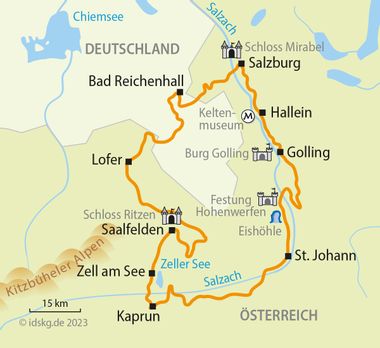
Prices / Dates
Services / Info
- Accommodation incl. breakfast
Cat. B: in guesthouses, inns and hotels at 3-star level
Cat. A: in inns and hotels at 3- and 4-star level - Room with shower/bath/WC
- Luggage transport
- Trip Kaprun - Krimml incl. bike (train or rail replacement service)
- Zell am See-Kaprun summer card
- Map of bike trails with marked route
- Tips for tour preparation
- Touristic information
- 7 days hotline service
Below please find more information about your Tauern Bike Trail and surroundings. If you have any further questions please feel free to contact us by phone: 0049 - (0)6421-886890.
Arrival by train
Salzburg is easily accessible from all major cities in Germany by train. We recommend to take a taxi from the station to get to our partner hotels in Salzburg. Current schedule information and price information can be found at:
Train schedule Deutsche Bahn and Train schedule OÖB
Parking at the hotel
You can park your car at the hotels in Salzburg for the duration of the trip.
Costs in category A € 25.00 per day and category B € 8.00 per day. A reservation in category A is required, this is not possible in category B. Parking costs are payable on site. You will receive detailed information on parking at the hotel booked for you with the detailed travel documents two weeks before the start of your journey.
Conditions of cycle paths
The Tauern Cycle Path is signposted continuously and in great detail. The route runs on quiet, paved bike paths and country roads, only partially on more heavily traveled routes. Some short parts also have to be mastered on unpaved bike paths. Overall, the quality of the paths can be described as very good. In some cases you have to reckon with slight inclines, so some basic fitness is recommended for this tour.
Available rental bikes
You can choose between a 7-speed unisex tour bike with hub shifting and a foot brake or a 21-speed unisex tour bike with chain shift and freewheel. The standard equipment includes a pannier, a handlebar bag with a map holder, a bicycle lock, an air pump, a spare hose and a small repair kit. Electric bicycles (without back-pedal) are bookable on request, as they are only available in limited numbers. You simply specify your wishes at time of booking.
Helmet duty in Austria
In Austria applies a helmet duty for children up to an age of 12 years.
Helmet obligation worldwide
Extra costs which are not included in the price
Any tourist tax and charging fees for bicycle batteries are not included in the tour price and must therefore be paid at the hotel.
7 day hotline service
Just in case the bike chain breaks, flooding makes it impossible to continue your tour or any other nasty surprise: You can reach us seven days a week and we will do anything to help you as fast as possible.
Passport and visa requirements
For EU citizens, there are no special passport or visa requirements and no health formalities to be considered for this trip.
Travel insurance
The tour price already includes the statutory insolvency insurance. In addition, we recommend that you take out travel cancellation insurance upon receipt of your travel confirmation in order to protect yourself against financial disadvantages in the event of travel cancellation, interruption of travel, illness or accident.

I provide you with advice and assistance
Steffi Groß
